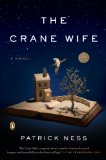Summary | Excerpt | Reviews | Beyond the Book | Read-Alikes | Genres & Themes | Author Bio

This article relates to The Crane Wife
"And all the stars were crashing round / As I lay eyes on what I'd found." The epigraph to Patrick Ness's novel comes from The Decemberists' 2006 album also entitled The Crane Wife. Clearly artists of all sorts have been inspired by the Japanese folktale on which Ness's novel is very broadly based.
The legend, known as Tsuru no ongaeshi, tells of a young man who rescues a crane that has been injured by a hunter's arrow. Later that day, the young man is surprised by a beautiful young woman on his doorstep, who introduces herself as his wife. Admitting that he is poor and cannot support a wife, the young man is surprised to discover that the mysterious woman can support their new family by creating beautiful weavings that sell for a high price. The only condition is that the man is never to watch his wife create her artwork.
 But curiosity overcomes him and, in a moment of weakness, he enters her weaving room, only to find the crane he saved, weaving cloth by plucking out her own feathers. The crane flies away, leaving the young man only with her final weaving. In some versions, the man, overcome by greed at their good fortune, pressures his wife to produce more and more, resulting in her declining health before the ultimate discovery of her true identity.
But curiosity overcomes him and, in a moment of weakness, he enters her weaving room, only to find the crane he saved, weaving cloth by plucking out her own feathers. The crane flies away, leaving the young man only with her final weaving. In some versions, the man, overcome by greed at their good fortune, pressures his wife to produce more and more, resulting in her declining health before the ultimate discovery of her true identity.
"The Crane Wife" belongs to a large group of folktales from different cultures about love interests, usually female, who shift shapes from animal to human form, rarely with lasting prospects for romantic happiness. The most familiar to us are likely the swan maidens of European folklore, who appear in various forms in Norse, Russian, and German tales. Variations of the story appear in the folklore of many other cultures, such as the Pacific Northwest Native Americans who tell tales of shape-shifting geese. Other animals can form the basis of these "animal bride" tales, such as the selkie (seal) brides of folklore from the Shetland and Orkney islands.
Such tales, which often explore the duplicitous nature not only of the shape-shifters but also of their human companions, continue to provide inspiration today, in all manner of arts including music, ballet (Swan Lake), in poetry and fantasy literature. Patrick Ness's The Crane Wife is a noteworthy addition to this tradition.
Picture depicting Crane Wife story from kawaix2.blogspot.com
Filed under Cultural Curiosities
![]() This "beyond the book article" relates to The Crane Wife. It originally ran in January 2014 and has been updated for the
December 2014 paperback edition.
Go to magazine.
This "beyond the book article" relates to The Crane Wife. It originally ran in January 2014 and has been updated for the
December 2014 paperback edition.
Go to magazine.
Your guide toexceptional books
BookBrowse seeks out and recommends the best in contemporary fiction and nonfiction—books that not only engage and entertain but also deepen our understanding of ourselves and the world around us.